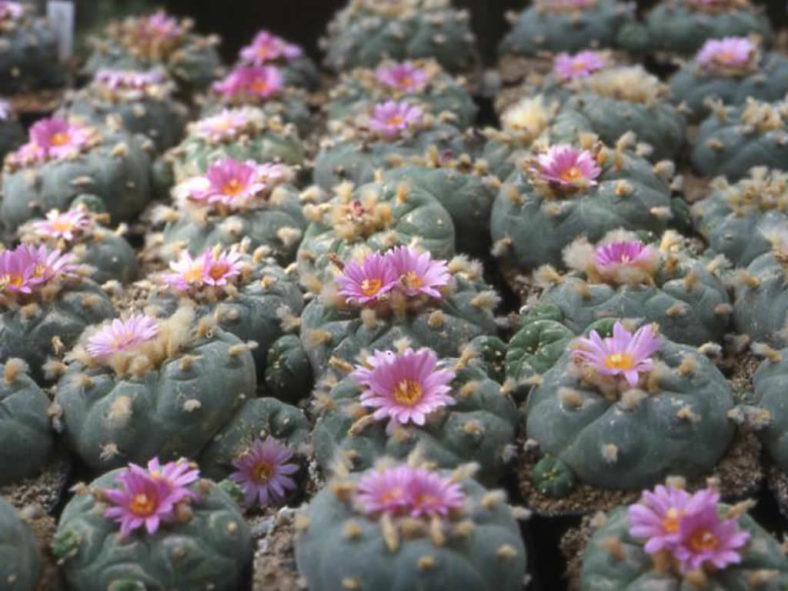Lophophora is a genus of spineless button-like cacti native to the southwestern United States (Texas and New Mexico) through northeast Mexico and south to Querétaro in central Mexico.
The species are highly slow-growing, sometimes taking up to thirty years to reach flowering age (at the size of a golf ball, excluding the root) in the wild. Cultivated specimens grow considerably faster, usually taking three to ten years to grow from seedlings to mature flowering plants. Unfortunately, the slow reproduction rate and over-harvesting by collectors put the species in the wild under threat.
Lophophora has been reported to comprise everything from one species, Lophophora williamsii, with varieties to the four species Lophophora diffusa, Lophophora fricii, Lophophora viridescens, and Lophophora williamsii. Most modern authorities consider Lophophora a genus of two species, Lophophora williamsii and Lophophora diffusa. Lophophora williamsii, commonly known as Peyote, is noted for its psychotropic alkaloids. These alkaloids are absent or only found in extremely small amounts in the other species, Lophophora diffusa.
Growing Conditions
Lophophora species easily adapt to cultivation. Although a cactus, most of the range this genus is found is within a subtropical climate for some years. In habitat, plants in this genus are subject to seasonal monsoons within their range. They live in areas where they may be underwater for several weeks during heavy rains and can tolerate a lot of water when temperatures exceed 100 °F (38 °C). These plants are heat-adapted and grow rapidly when exposed to 110 to 120 °F (43 to 49 °C) and watered heavily in the summer. In habitat, plants from areas that experience seasonal monsoons and high temperatures, such as southern Texas, can reach flowering size in five years. During the fall and winter months, the plants receive almost no water in their habitat and are subjected to temperatures that can drop below 20 °F (−7 °C). The plants should not be watered during the winter rest or watered sparingly when they begin to shrink and wrinkle, only enough to keep them turgid. Lophophoras must be kept completely dry if they are subjected to temperatures below 40 °F (4 °C), as watering plants and subjecting them to below-freezing temperatures will typically result in the plant's death.

General Care
Lophophoras are closely related to the genera Ariocarpus, Aztekium, and Obregonia. Like their relatives, they possess a large taproot system with most of the plant's mass underground for water storage. However, Lophophoras are more tolerant of soil types than their relatives and typically grow in areas with decomposed limestone present in the soil. In cultivation, Lophophoras do best in a fast-draining mineral-based soil, which is about two-thirds sand. Abundant water is beneficial in the summer when temperatures are over 90 °F (32 °C) and exposed to full sunlight for maximum growth. Still, the soil must be allowed to dry out completely between waterings. They should also be fertilized twice a year. Over-fertilizing will typically result in the Lophophoras developing cracks and splitting. Some Lophophoras may develop a corky material on the plant body if exposed to pesticides or insecticidal soap. This corky condition will usually heal similarly to human skin if the plants are exposed to full sunlight.
Lophophoras are free flowering in cultivation, and although they can withstand low temperatures during winter, they do not require a cold shock to initiate flowering. Plants in their native habitat typically flower after rainstorms, preceded by high temperatures and dry conditions. Plants in cultivation can be encouraged to bloom by subjecting the plants to high temperatures, direct sunlight, and withholding water for several weeks, then watering heavily, usually initiating flowering.
Propagation
Seedlings grow most rapidly when enclosed in a sealed terrarium environment, germinated in trays of shallow sand covered with plastic wrap with several small pin-sized holes in the plastic wrapping. This may seem strange for a cactus, but Lophophora seedlings are adapted to germinate and grow during the seasonal monsoons. Plants grown this way can reach a diameter of 2 inches (5 cm) in just over a year and can be removed from their hyper-humid environment approximately two months after germination. They will typically reach flowering size in only under three years via this method.
Disclaimer
The contents of this article are for educational and gardening information purposes only.
Source: wikipedia.org
Links
- Back to genus Lophophora
- Succupedia: Browse succulents by Scientific Name, Common Name, Genus, Family, USDA Hardiness Zone, Origin, or cacti by Genus